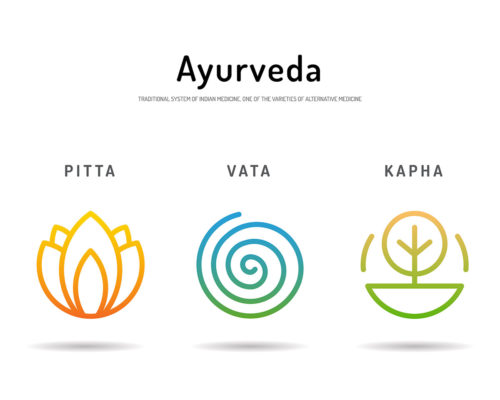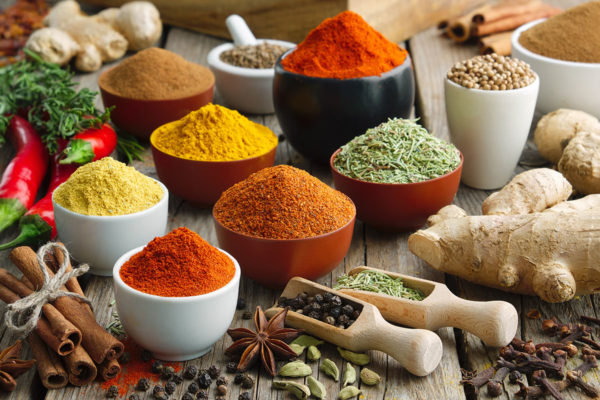Ayurveda is a traditional holistic Indian system of medicine that has been used for thousands of years to promote balance and harmony in the body and for disease management. In the US currently, it is an alternative healthcare practice.
According to Ayurveda, there are five elements (earth, water, fire, air and ether) that combine to form three Doshas, or functional energies. Vata( the energy of movement formed by the combination of air and ether), Pitta (fire and water combine to form the energy of metabolism), and Kapha (earth and water combine to form this energy of cohesion). At the time of conception, these energies combine and govern our constitution through our structure, function, affinities and tendencies.
The mind is clear, light and blissful and carries the quality of Sattva. This can go out of balance when there is Rajas (ambition, restlessness, irritability and feverishness) in the body or Tamas (heaviness and dullness). These qualities or Gunas keep changing; as an example, we do need Rajas to wake up and Tamas to sleep!
In this blog post, we will explore how yoga and meditation can be used to balance the Doshas and promote overall health and wellbeing. These practices are considered Sattvik as they restore the blissful, clear quality of the mind.
Yoga and Meditation to Balance the Doshas and Improve Your Health
Each Dosha has its own unique qualities and characteristics, and an imbalance in any of the Doshas can lead to physical and mental health problems.
Ayurveda and Yoga
Ayurveda and yoga are closely linked, and both emphasize the importance of balance and harmony in the body. They both have their origin in the Vedas. Ayurveda uses yoga to balance the doshas and promote overall health and wellbeing. All eight limbs of yoga, from pranayama, to asanas to meditation are customized to restore specific imbalances which calming the mind and reducing stress.
Meditation and Ayurveda
Meditation is another powerful tool for restoring health and balancing the Doshas. It reduces stress, improves the mood, and enhances mental clarity and focus. Many diseases are psychosomatic and could lead to or exacerbate mental health challenges. Meditation is a powerful tool used by Ayurvedic Practitioners. Mental health is also closely linked to improved immune function, which is restored through the practice of regular meditation.
The Three Doshas

There are three doshas in Ayurveda: Vata, Pitta, and Kapha. Each dosha has its own unique characteristics and qualities. Here is a brief overview of each dosha:
1. Vata
- Qualities: Dry, light, cold, rough, and mobile
- Imbalance: Anxiety, insomnia, constipation, and dry skin
- Suggested Poses and Techniques:
- Slow, gentle movements that emphasize grounding and stability
- Seated meditation with a focus on deep breathing
- Warm, nourishing foods and drinks, such as soups and herbal teas
- Slow, deep breathing (not very stimulating breathwork), Alternate Nostril Breathing
Vata Poses include:
-
- Mountain Pose (Tadasana)
- Warrior II (Virabhadrasana II)
- Tree Pose (Vrksasana)
- Camel Pose (Ustrasana)
- Seated Forward Fold (Paschimottanasana)
- Corpse Pose (Savasana)
2. Pitta
- Qualities: Hot, sharp, light, and oily
- Imbalance: Acid reflux, skin rashes, and anger
- Suggested Poses and Techniques:
- Cooling and calming poses, such as forward folds and gentle twists
- Breathing techniques that emphasize cooling and relaxation, such as Alternate Nostril Breathing
- A diet that includes cooling and hydrating foods, such as cucumbers and watermelon
Pitta Poses include:
-
- Forward Fold (Uttanasana)
- Child’s Pose (Balasana)
- Extended Triangle (Utthita Trikonasana)
- Seated Twist (Marichyasana III)
- Supported Shoulderstand (Salamba Sarvangasana)
- Corpse Pose (Savasana)
3. Kapha
- Qualities: Heavy, slow, stable, and oily
- Imbalance: Weight gain, lethargy, and depression
- Suggested Poses and Techniques:
- Active, energizing poses, such as Sun Salutations
- Breath of Fire breathing technique to increase energy and warmth
- A diet that includes spicy and stimulating foods, such as ginger and cayenne pepper
Kapha Poses include:
-
- Sun Salutation A (Surya Namaskar A)
- Warrior I (Virabhadrasana I)
- Boat Pose (Navasana)
- Bridge Pose (Setu Bandhasana)
- Plow Pose (Halasana)
- Corpse Pose (Savasana)
How to Use Ayurveda with Yoga and Meditation

Through the regular practice of yoga and meditation, you can balance Doshas and this is part of a preventive regimen. Knowing your constitution helps! If you have any imbalance, an Ayurvedic Practitioner can help you assess what Doshas are out of balance and recommend a specific yoga practice. Remember to be patient and persistent, and don’t get discouraged if you don’t see immediate results.
The benefits of Ayurveda, yoga and meditation come with regular practice and a commitment to your health and wellbeing. If you are interested in learning more about Ayurveda, consider consulting with a certified Ayurvedic practitioner.

